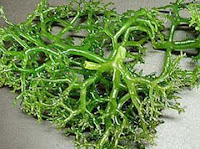 Seaweed is a type of grass that grows in the sea and is very much beneficial for health, sea grass is very rich in content - rich in vitamins and other compounds.
Seaweed is a type of grass that grows in the sea and is very much beneficial for health, sea grass is very rich in content - rich in vitamins and other compounds. As common in other types of algae, seaweed morphology Glacilaria type called a thallus (plural thalli), which has no real difference between the roots, stems and leaves. Breeding done in 2 ways by mating between male gametes and female gametes (generative) and do not marry via vegetative, conjugatively and spread spores contained in the pockets of spores (carporspora, cystocarp).
Based on pigment content, seaweed is grouped into 4 classes (othmer, 1986; Anomin, 1977) namely: Rhodophyceae (red algae) Phaeophyceae (brown algae), Chlorophyceae (green algae), Cyanophyceae (blue-green algae). Some types of grass that economic value has always been traded namely Eucheuma sp., Hynea sp., Gracillaria sp., And Gelidium sp., Of the class Rhodophyceae and Sargassum sp., Of the class Phaeophyceae.
Seaweed Benefits
Benefits of seaweed based study recorded 22 species have been used as food. Waters in the region of South Sulawesi, Southeast Sulawesi, Seram Island, Bali, Lombok, Riau Islands and Pulau Seribu 18 types known to be used as food and 56 species as food and traditional medicine by the coastal communities.
From the results recorded as many as 61 studies of 27 species of seaweed in Kepulauan Riau, Lampung Beach, Island of Java, Madura, Bali, NTB, NTT, South Sulawesi, Southeast Sulawesi, Maluku Islands, and some familiar food. The amount is dominated by 38 species from 17 red algae, 15 species of green algae from 5 and 8 species of 5 brown algae. Of the 21 species have been used as a drug.
Indonesia, the country is fertile and rich in natural resources. As a country with a vast sea area of more than 70%, one of the natural wealth that we can use is the source of biodiversity. In addition to fish, seafood alternatives that can be processed is seaweed.
Seaweed is included in the algae (plants have chlorophyll or green leaf substance). Plants that live and stick to the shallow waters of the dead coral is divided into 4 major classes, namely Rhodophyceae (red algae) Phaeophyceae (brown algae), Chlorophyceae (green algae), and Cyanophyceae (blue-green algae).
Seaweed is widely used as industrial raw materials. Examples of brown algae, which are used for ice cream raw materials, textile processing, pharmaceutical manufacturing, shoe polish, and paint factory. Red algae as raw material for food industry, pharmaceutical, leather tanning, and brewing.
Also, seaweed can also be used as material for the fertilizer plant, mixed fodder, as well as cosmetic raw materials.
Seaweed is known to be rich in essential nutrients, such as enzymes, nucleic acids, amino acids, minerals, trace elements, and vitamins A, B, C, D, E and K. Due to the high nutritional content, seaweed can improve work systems hormonal, lymphatic, and nervous too. Also, seaweed can also increase the body's defense function, improve heart and circulatory, and digestive system.
Seaweed is also known as traditional medicine for coughs, asthma, bronchitis, tuberculosis, intestinal worms, abdominal pain, fever, rheumatism, and even believed to increase sexual power. Body needs iodine to prevent goiter disease.
In China, sea grasses are also commonly used for cancer treatment. The high level of consumption of seaweed may be associated with a lower incidence of breast cancer in women in the country. Perhaps it is caused by the chlorophyll content of seaweed that is antikarsinogenik. In addition, because the content of vitamin C and antioxidants that fight free radicals, the seaweed is useful to extend life and prevent premature aging.
All sea rumut rich in fiber can prevent colon cancer. Fiber can aid digestion by forming substances such as gelatin in the small intestine and increase the water content in fases. Consumption of fiber may help fat metabolism resulting in lower blood cholesterol levels and blood sugar. Seaweeds also help treat peptic ulcers, colitis, constipation and other digestive disorders.
Seaweed utilization in General are:
- Food and milk (Ice cream, yogurt, waper cream, chocolate milk, instant pudding)
- Beverages (Soft drinks, fruit juices, beer)
- Bread
- Candy
- Meat fish in cans
- Sauces, salad dressings, soy sauce
- Food diet (Jelly, jam, syrup, pudding)
- Baby food
- Non-food (animal food, fish food, paint, ceramics, textiles, paper)
- Pharmacy and koxsmetik (toothpaste, shampoo, medicine tablet, tooth print materials, ointment)





Tidak ada komentar:
Posting Komentar